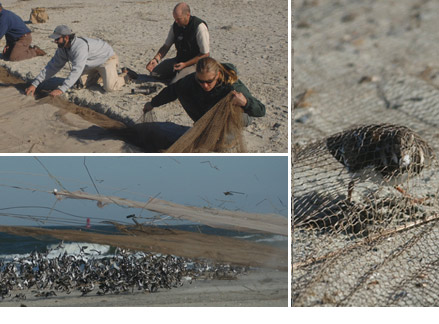


Averting the Next Pandemic
by Sam Fahmy
Intro
|
What's a Danger, And What's Not
|
Staying Ahead Of The Threat
|
Taking A Broad Perspective

![]()
Staying Ahead Of The Threat
Swayne, Stallknecht and their colleagues at Southeast Poultry and SCWDS have long been working to better understand avian influenza and its role in the environment—way before it became the disease du jour.
Since coming to Southeast Poultry in 1994, Swayne has helped to nearly triple the amount of federal support that the facility receives—from $2.7 million to more than $7 million in USDA funding—a good fraction of which is devoted to avian influenza. Among other notable accomplishments, research conducted by Swayne and his staff led to the licensing in 1998 of the first H5 vaccine—to international veterinary-vaccine manufacturer Merial Ltd.—which has since sold more than one billion doses. The researchers are currently working to develop vaccines for other avian influenza types and learn the most effective ways to administer the vaccines.

(Top Left) Wildlife biologists from the USDA and the Georgia DNR coil the cannon net before attempting to capture, test, and band a group of shorebirds on Tybee Island, GA in December 2006. (Bottom Left) Two nets, fired simultaneously, “ground” the birds for easy capture. (Right) Once the birds are captured, biologists work quickly to minimize stress.
In 2002, Southeast Poultry staff led by David Suarez devised a new diagnostic test for avian influenza that has substantially reduced the time it takes to identify the virus—from one or two weeks to just three hours. Southeast Poultry researchers also identify and, often, further study avian influenza viruses that are sent to their lab from around the world. If the high-path Asian strain of H5N1 ever makes its way to North America, researchers at Southeast Poultry will likely be the ones to identify it.
In Southeast Poultry’s work with SCWDS, one of the most enduring collaborations between the two labs is their eight-year-old effort to monitor migratory birds for avian influenza viruses. Slemons at Ohio State and Kevin Winker at the University of Alaska-Fairbanks also contribute to the effort, which allows scientists to track how the dominant viral species change through time and move through populations. So far the researchers have sampled over 12,000 birds and cataloged more than 1,000 viruses.
Researchers from Swayne’s and Stallknecht’s facilities also collaborated on a study published last fall that identified two species—the common wood duck and laughing gull—that are very susceptible to high-path Asian H5N1 avian influenza viruses and have the potential to transmit them. The scientists also found that other birds known to be important avian influenza virus reservoirs, such as mallards, Northern pintails and blue-winged teal, are not highly susceptible and probably not likely to transmit H5N1.
In low-path avian influenza, most of the virus is shed in the birds’ feces. The virus then spreads as other birds drink from contaminated water. The researchers found that in high-path Asian H5N1 avian influenza, however, the birds shed most of the virus through their respiratory tracts. Knowing more about which birds to look for and the best way to collect samples, researchers are in a better position to quickly detect H5N1 if it were to arrive in North America.
Intro
|
What's a Danger, And What's Not
|
Staying Ahead Of The Threat
|
Taking A Broad Perspective
For comments or for information please e-mail: rcomm@uga.edu
To contact the webmaster please email: ovprweb@uga.edu
![]()